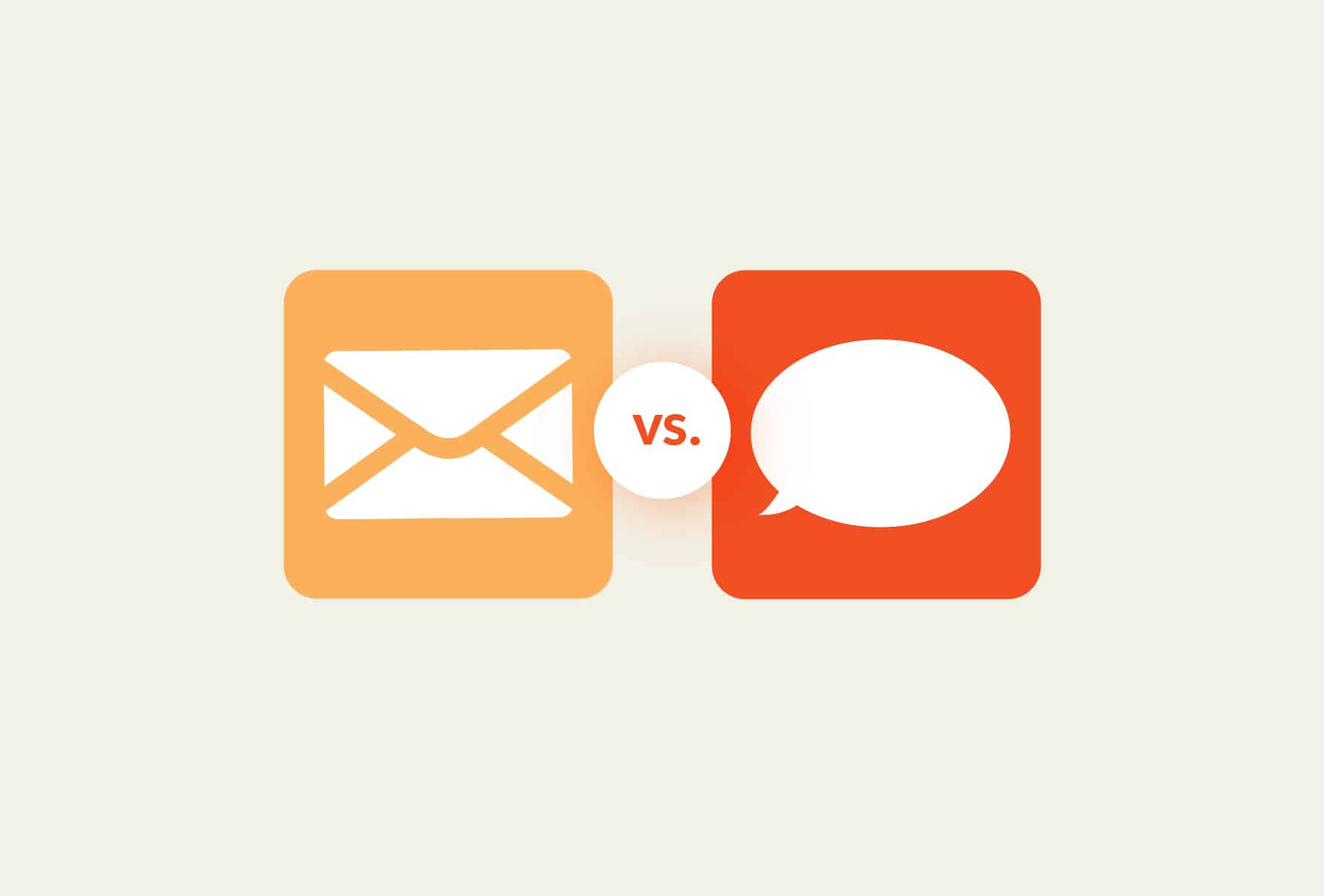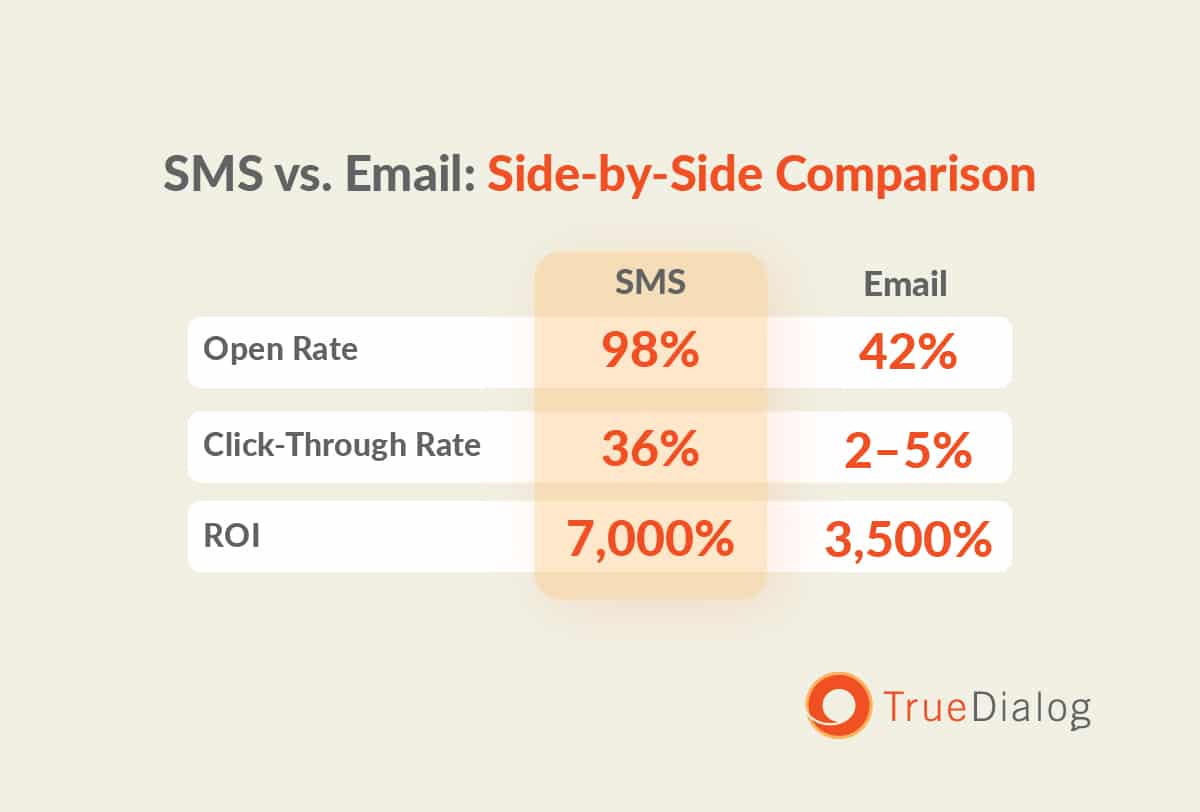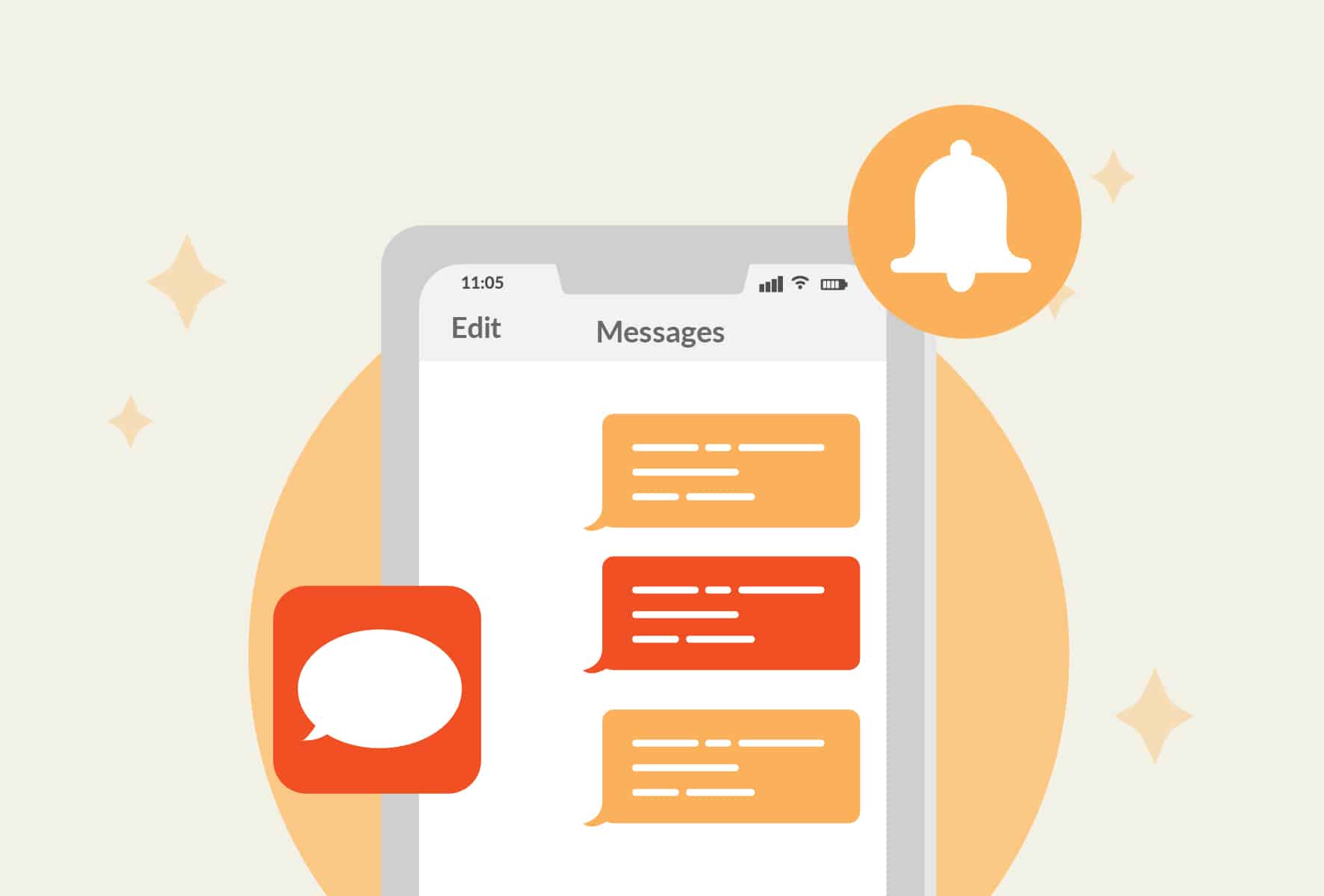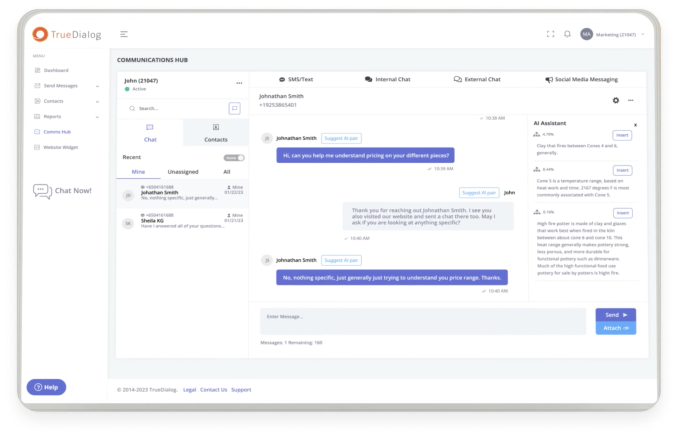While it’s easy to romanticize the simplicity of bygone eras, being a marketer in the digital age comes with some pretty stellar advantages. Like, for example, the fact that there’s no shortage of channels you can leverage to communicate with your audience.
The drawback? It’s virtually impossible to be everywhere at once — at least, not without an unlimited budget. Most of us need to be judicious with how we spend our time and resources, only placing our eggs in the basket(s) most likely to achieve our goals.
Recently, with unpredictable algorithms and surging digital advertising costs making it harder to reach audiences on social media, SMS and email have re-emerged as marketers’ preferred channels. But, when it comes to SMS marketing vs. email marketing, where are you more likely to see the best results?
In this article, we’ll explore these top digital channels and compare their advantages and disadvantages so you can make the right choice.
What Is SMS Marketing?
SMS (Short Message Service) marketing is a type of direct digital marketing businesses use to connect with their contacts and deliver promotions, reminders, announcements, and other relevant updates via text messages. As long as you get permission from your contacts and follow industry regulations (which we’ll dive into later), SMS is one of the best ways to quickly reach people anywhere they take their mobile devices.
Key Features and Common Use Cases of SMS Marketing
While some businesses have been using SMS marketing for decades, this channel has grown substantially over the past several years. According to a 2024 study, more than half of organizations (54%) rank SMS as the most effective channel for generating a response.
Here are a few of the most powerful SMS features (and how businesses use them):
- Two-way communication: SMS is an excellent two-way communication channel that makes it easy for businesses to respond to contacts’ questions, gather customer feedback, and deliver personalized support in real-time. Because most people already have a mobile device — and SMS is available on nearly all modern cell phones — it’s a comfortable, convenient, and highly accessible option for connecting directly with individuals.
- For example, a bank might use two-way texting to verify whether a customer’s recent card transaction was fraudulent or collect feedback about a new account feature.
- Rapid delivery: Depending on the SMS platform you use, your texts can reach recipients’ devices in seconds. And, given the prevalence of mobile devices (and the fact that we can’t help but check our devices countless times per day), the vast majority of SMS messages are read in minutes — which makes this channel the perfect choice for timely communications (like flash sales) or critical information (like urgent alerts).
- For example, a university might use SMS messaging to notify students about safety issues or campus closures amid severe weather.
- Concise and actionable: Because SMS messages are short (160 characters or less), they don’t require a lot of time or mental energy to consume — which makes this channel a prime option for driving immediate engagement. By using clear copy and a compelling call to action (CTA), organizations can prompt recipients to follow through quickly.
- For example, a B2B tech company might use SMS messaging to drive webinar sign-ups, or a service provider may use texting to confirm appointments.
What Is Email Marketing?
Email marketing is another popular type of direct digital marketing. In this case, businesses send promotional or informational messages to subscribers’ email inboxes. Much like SMS marketing, organizations often use email marketing to nurture relationships with prospects, foster customer loyalty, and increase sales. Because many people check their email on their phones, it’s also a great way to connect with audiences on the go.
Key Features and Common Use Cases of Email Marketing
Ever since free webmail services landed on the scene in the mid-1990s, email has remained one of the most popular communication channels — especially for business use. According to recent data, approximately 92% of people in the U.S. use email, and most people check their inboxes at least once a day.
Here are a few handy email features, and insight into how organizations leverage them:
Direct access to individuals
- While traditional channels rely on a one-to-many approach, email supports direct,
- personalized connections with subscribers — and, unlike social media, it’s free from the whims of an ever-changing algorithm. This makes it an excellent option for communicating information one-on-one.
- For example, a university might use email to inform a student of their financial aid award or share a calendar of campus events relevant to their major.
Enables long-form messaging
- While email service providers may clip messages at a certain size (usually about 100 kilobytes), email doesn’t have a character limit. This makes it a better option when you need to convey a large amount of information at once.
- For example, B2B software companies often use email to share updates to their terms of service or deliver newsletters highlighting product updates, recent blog posts, and industry news.
Highly visual
- Email supports visual components — like images, graphics, buttons, and custom formatting. This makes it well-suited for delivering a more vibrant and immersive branded experience with multiple CTAs.
- For example, a baseball stadium may use email — designed with team colors and high-resolution images of the stands — to sell tickets to an upcoming game and promote season passes.
SMS vs. Email: Side-by-Side Comparison
Both SMS and email can deliver impressive results, but there are some areas where one channel outperforms the other. That’s why it’s helpful to compare SMS vs. email marketing across a few performance metrics and other key considerations.
Open Rates and Engagement
You could spend hours meticulously crafting the most powerful marketing message ever written — but if your recipients don’t bother opening it, then it’s all for nothing. That’s why it’s important you choose a channel where your audience is active (and your marketing brilliance won’t be wasted).
And, if we’re judging by opens, then SMS ranks at the tip-top with an astounding 98% open rate. In other words, almost every single text message is eventually opened. On the other hand, email open rates peak at around 42%, according to MailerLite.
But, if we choose based on click-throughs and conversions… SMS still wins. In our recent roundup of SMS marketing statistics, we shared that links within SMS texts generate a click-through rate (CTR) of about 36%, and conversions typically fall between 20 and 30%.
Meanwhile, according to Campaign Monitor, a good email CTR is anything between 2 – 5% and ActiveCampaign reports that the average conversion rate for email hovers around 15%.
So, if you’re trying to decide between email marketing vs. SMS marketing based on these factors alone, SMS is the clear choice.
Cost and ROI
If you’re wondering which channel will give you the most bang for your buck, SMS marketing stands out yet again.
According to Litmus, every $1 a business spends on email marketing generates about $36, for a massive ROI of 3500%. However, G2 found that for each $1 brands invested in SMS marketing, they earned $71 in revenue, which calculates to a bewildering 7000% ROI. In other words, as a marketing channel, SMS generates double the returns of email.
That said, these ROIs aren’t guaranteed and depend on several other factors, such as your industry, audience, type of campaign, and the technology you use. For example, when it comes to SMS success, the mass texting service you choose will have a significant impact on your revenue. In addition to monthly or annual plan costs, you’ll also need to factor in whether the provider marks up carrier pass-through fees and whether you’ll need to invest in additional software (like Zapier) to manage integrations with your CRM, which can eat into your margins.
Deliverability and Timing
While both SMS and email marketing messages can arrive within seconds of being sent, delivery speed depends on the platform you choose to manage your campaigns, as well as technical issues like server load and network conditions.
For example, when email servers become overloaded with too much activity, it can delay message delivery by minutes (or even hours). Similarly, if there’s too much demand on a cellular network or a sender or recipient has a weak connection, it can take several minutes for a message to arrive.
Again, this is why it’s vital you choose a solution designed to boost deliverability and ensure your messages arrive on time — like TrueDialog. While many business SMS platforms rely on third-party aggregators, TrueDialog maintains direct connections with carriers to help ensure messages bypass bottlenecks and reach recipients faster.
However, timing is one area where email has a slight edge. While federal regulations restrict businesses from sending promotional text messages during so-called “quiet hours” (8 p.m. – 9 a.m. in the recipient’s time zone), you’re free to send emails at any time of day or night. (That said, transactional SMS messages, such as reminders or shipping notifications, don’t necessarily need to comply with quiet hours requirements.)
Compliance and Opt-In Rules
Regardless of whether you’re using email marketing or SMS marketing, you still have to get explicit consent from recipients before you can begin sending them messages, and also offer an easy way for people to opt out. However, because SMS is a telecom channel, it’s typically held to stricter standards than email. For example, when sending SMS messages, businesses have to follow the rules set forth by the Telephone Consumer Protection Act (TCPA) and Cellular Telecommunications Industry Association (CTIA) regulations, and comply with the Do Not Call Registry.
That said, newer regulations like CAN-SPAM, the General Data Protection Regulation (GDPR), and Canada’s Anti-Spam Legislation (CASL) mean email marketing is facing increasingly strict rules as well — especially when sending international campaigns.
This is yet another reason it pays to work with the right platform. For example, TrueDialog includes built-in SMS compliance features that protect consumer data and help reduce your organization’s legal risks.
Pros and Cons of Each Channel
If you’re still struggling to understand the differences between email vs. SMS marketing and where each channel performs best, here’s a simple breakdown of the top pros and cons.
Pros and Cons of SMS Marketing
Here are the key advantages and disadvantages of SMS marketing:
Pros:
- Ultra-high open rates
It’s hard to compete with a 98% open rate. And, in addition to the fact that most recipients open all of their SMS messages, they also do so within minutes of receiving them. - Superior engagement
People don’t just open their texts — they interact with them too. Over one-third of the people who open their SMS messages also click through, and a significant number of them also convert. - More direct
Not only do people generally check their texts more frequently than their email inboxes, but it’s also less competitive than email. In other words, it’s a little easier to stand out in a text inbox than a cluttered email inbox.
Cons:
- Limited length
With just 160 characters, you’re limited with how much information you can convey in a single text message. However, not every marketing message needs to be a lengthy missive. (And if you do need more than a standard text allows, you could always use MMS or RCS, which offer larger character limits and rich media options.) - Smaller audiences
Fewer people subscribe to text marketing than email marketing, so you may not be able to reach as much of your audience if you rely only on SMS marketing. But this trend may soon change. An eMarketer survey found that millennials and Gen Z consumers prefer text messages to emails when engaging with brands.) - Stricter compliance requirements
As mentioned earlier, SMS marketing has more rigid compliance requirements than email marketing, and brands can face stiff penalties for failing to comply with industry regulations.
Pros and Cons of Email Marketing
Here are the top strengths and weaknesses of email marketing:
Pros:
- Wider reach
Even though there are more mobile phone owners than active email users (globally speaking), fewer people subscribe to SMS marketing than to email marketing. - Supports longer-form content
There is no concrete character limit for email. So, although it’s unwise to overwhelm your audience with giant walls of text, you can convey more information via email than in a SMS message. - Cost-effective
Email is one of the most affordable marketing channels available, and generally boasts a lower average cost-per-message than SMS. (That said, SMS also generates a significantly higher ROI.)
Cons:
- Lower open and engagement rates
With CTRs in the single digits and less than one-third of emails ever being opened, email isn’t the most reliable channel for delivering your message. - More competition
Currently, more brands leverage email marketing than SMS marketing (although this is changing, since SMS marketing adoption has climbed significantly in recent years). In other words, it can be hard to stand out within cluttered email inboxes. - Slower response times
While most people read their text messages within minutes, email messages often sit unopened for hours or even days before a recipient engages.
When to Use SMS, Email, or Both
Although texting has become the default form of communication for most people in 2025 — especially since more than 98% of Americans own a mobile phone, according to Consumer Affairs — email remains the primary channel for lead generation for most brands for good reason. And while many marketers are stuck debating whether text vs. email marketing is more effective overall, the smarter question might be: how can you leverage both channels?
Here are a few questions to ask as you evaluate which channel to use for each type of campaign:
- Who is my target audience, and what have they opted in to receive?
- Review your consent data to help you determine whether your contacts prefer text or email. For example, while an audience of university students may favor SMS, a contact list of senior executives may prefer to receive communications via email.
- Review your consent data to help you determine whether your contacts prefer text or email. For example, while an audience of university students may favor SMS, a contact list of senior executives may prefer to receive communications via email.
- What is my ultimate goal with this campaign?
- What is the primary objective of this send? For example, if you want to drive immediate action, it may be better to send the message via SMS. If you want to educate your subscribers on a nuanced topic, email is likely the better bet.
- What is the primary objective of this send? For example, if you want to drive immediate action, it may be better to send the message via SMS. If you want to educate your subscribers on a nuanced topic, email is likely the better bet.
- How time sensitive is this message?
- People typically engage with their SMS inboxes more frequently than they do with their email inboxes. So, if you have an urgent message to deliver, it’s smarter to send it as a text.
- People typically engage with their SMS inboxes more frequently than they do with their email inboxes. So, if you have an urgent message to deliver, it’s smarter to send it as a text.
- How much information do I need to share?
- SMS is great for short, direct messages with a single CTA. But if you need space for more detailed explanations, visuals, storytelling, or want to drive more than one action, email is the clear winner.
- SMS is great for short, direct messages with a single CTA. But if you need space for more detailed explanations, visuals, storytelling, or want to drive more than one action, email is the clear winner.
- Is this a good opportunity for a multi-channel approach?
- While there are times when you’ll need to choose between SMS vs. email, these channels drive the best results when you use them in tandem.
- For example, a B2B software company might use email to introduce a new feature, then send a quick SMS encouraging contacts to schedule a demo so they can see the new feature in action. Or, a sports team might use email to share the upcoming season schedule, then use SMS to promote a flash sale on season passes.
How TrueDialog Supports Both Channels
After years of economic uncertainty and constantly changing consumer behaviors, you might assume the best tactic is to cut one channel to focus entirely on another. But when the decision comes down to SMS marketing vs. email marketing, it’s not as straightforward. Fortunately, by using the right platforms, you don’t have to choose between them. With TrueDialog, you can generate massive ROI from SMS campaigns while integrating your texts into multi-channel efforts.
Because the platform unifies SMS and email — as well as voice, social messages, and chat — onto a single, centralized platform, you can enhance engagement across channels. And thanks to native integrations with HubSpot, Marketo, and other top marketing automation tools and CRMs, you can streamline your workflow for easier omnichannel campaign management.
Additionally, with TrueDialog’s robust SMS analytics and reporting, you’ll get real-time insights into campaign deliverability, CTR, and more — plus enterprise-grade deliverability tools that help reduce your risk of triggering carrier spam filters.
Instead of choosing between text marketing vs. email marketing, you can maximize the benefits (and revenue potential) of both channels.
###







